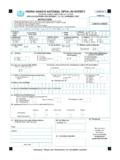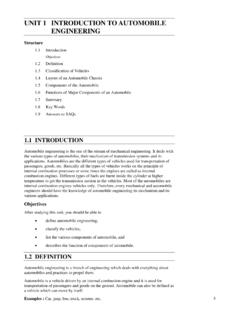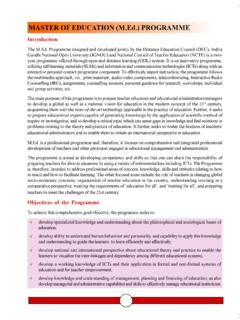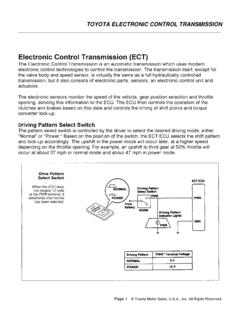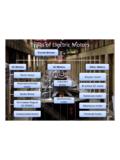Transcription of UNIT 3 AUTOMOBILE ELECTRICAL Automobile Electrical …
1 21 AUTOMOBILE ELECTRICAL Systems UNIT 3 AUTOMOBILE ELECTRICAL SYSTEMS Structure Introduction Objectives Ignition System Requirement of an Ignition System Types of Ignition Systems Battery or Coil Ignition System Magneto-ignition System Electronic Ignition System Charging System Starting System Functions of Components used in Circuits Battery Ignition or Induction Coil Contact Breakers Condenser Distributor Ignition Switch Spark Plugs Magneto Functions and Working Principles of Main Components of ELECTRICAL Systems starter Dynamo or Generator Alternator or AC Generator Regulators for Alternator Regulators for Dynamo Cutout Relay Ignition Timings Effect of Ignition Advance and Ignition Retard Need of Spark Advance/Retard Mechanisms Types of Spark Advance/Retard Mechanisms Centrifugal Spark Advance Mechanism Vacuum Advance Mechanism Summary Key Words Answers to SAQs INTRODUCTION AUTOMOBILE ELECTRICAL system includes starting system, charging system, ignition system and lighting system and some accessories.
2 The accessories include cigarette lighter horn and mobile charging system, etc. 22 AUTOMOBILE Engineering Major components of a typical ELECTRICAL systems are given below : Ignition System (a) Spark plugs (for petrol vehicle) (b) Distributor (c) Ignition coil (d) Ignition switch, etc. Charging System (a) Alternator (b) Regulator, etc. Starting System (a) Battery (b) Starting motor (c) Wiring, (d) Switches, etc. Objectives After studying this unit, you should be able to define ELECTRICAL system, understand about major components of the ELECTRICAL system, describe the types of ignition systems, know the starting system of an AUTOMOBILE , and explain the functions of components used in ELECTRICAL system circuits.
3 IGNITION SYSTEM In spark ignition engines, a device is required to ignite the compressed air-fuel mixture at the end of compression stroke. Ignition system fulfills this requirement. It is a part of ELECTRICAL system which carries the electric current at required voltage to the spark plug which generates spark at correct time. It consists of a battery, switch, distributor ignition coil, spark plugs and necessary wiring. A compression ignition engine, a diesel engine does not require any ignition system. Because, self ignition of fuel air mixture takes place when diesel is injected in the compressed air at high temperature at the end of compression stroke. REQUIREMENTS OF AN IGNITION SYSTEM (a) The ignition system should be capable of producing high voltage current, as high as 25000 volts, so that spark plug can produce spark across its electrode gap.
4 (b) It should produce spark for sufficient duration so that mixture can be ignited at all operating speeds of AUTOMOBILE . (c) Ignition system should function satisfactory at all engine speeds. (d) Longer life of contact points and spark plug. 23 AUTOMOBILE ELECTRICAL Systems (e) Spark must generate at correct time at the end of compression stroke in every cycle of engine operation. (f) The system must be easy to maintain, light in weight and compact in size. (g) There should be provision of spark advance with speed and load. (h) It should be able to function smoothly even when the spark plug electrodes are deposited with carbon lead or oil. TYPES OF IGNITION SYSTEMS There are three types of ignition systems which are used in petrol engines.
5 (a) Battery ignition system or coil ignition system. (b) Magneto ignition system. (c) Electronic ignition system. In battery ignition system, the current in the primary winding is supplied by a battery whereas it is supplied by a magneto in magneto ignition system. Battery ignition system is used in cars and light truck. Magneto ignition system is used in some scooters. Both the systems work on the principle of mutual electromagnetic induction. Electronic ignition systems use solid state devices such as transistors and capacitors. Battery or Coil Ignition System Battery ignition system consists of a battery of 6 or 12 volts, ignition switch, induction coil, contact breaker, condenser, distributor and spark plugs.
6 A typical battery ignition system for four cylinder SI engine has been shown in Figure Figure : Battery or Coil Ignition System The primary circuit consists of battery, switch, primary winding and contact breaker point which is grounded. A condenser is also connected in parallel to the contact breaker points. One end of the condenser is grounded and other connected to the contact breaker arm. It is provided to avoid sparking at contact breaker points so as to increase their life. The secondary ignition circuit consists of secondary winding distributors and spark plugs. All spark plugs are grounded. The ignition coil steps up 12 volts (or 6 volt) supply to a very high voltage which may range from 20,000 to 30,000 volts.
7 A high voltage is required for the spark to jump across the spark plug gas. This spark ignites the air-fuel mixture as the end of compression stroke. The rotor of the distributor revolves and distributors the current to 24 AUTOMOBILE Engineering the four segments which send the current to different spark plugs. For a 4-cylinder engine the cam of the contact breaker has four lobes. Therefore, it makes and breaks the contact of the primary circuit four times in every revolution of cam. Because of which current is distributed to all the spark plugs in some definite sequence. The primary winding of ignition coil has less number of turns ( 200 turns) of thick wire. The secondary winding has relatively large number of turns ( 20,000 turns) of thin wire.
8 When ignition switch in turned on, the current flows from battery to the primary winding. This produces magnetic field in the coil. When the contact point is open, the magnetic field collapses and the movement of the magnetic field induces current in the secondary winding of ignition coil. As the number of turns in secondary winding are more, a very high voltage is produced across the terminals of secondary. The distributor sends this high voltage to the proper spark plug which generates spark for ignition of fuel-air mixture. In this way, high voltage current is passed to all spark in a definite order so that combustion of fuel-air mixture takes place in all cylinders of the engine.
9 A ballast register is connected in series in primary circuit to regulate the current. At the time of starting this register is bypassed so that more current can flow in this circuit. The breaker points are held by a spring except when they are forced apart by lobes of the cam. Advantages (a) Low initial cost. (b) Better spark at low speeds and better starting than magneto system. (c) Reliable system. (d) No problems due to adjustment of spark timings. (e) Simpler than magneto system. Disadvantages (a) Battery requires periodical maintenance. (b) In case of battery malfunction, engine cannot be started. Magneto-ignition System This system consists of a magneto in place of a battery.
10 So, the magneto produces and supplies current in primary winding. Rest of the system is same as that in battery ignition system. A magneto ignition system for a four cylinder SI engine has been shown in Figure The magneto consists of a fixed armature having primary and secondary windings and a rotating magnetic assembly. This rotating assembly is driven by the engine. rotation of magneto generates current in primary winding having small number of turns. Secondary winding having large number of turns generates high voltage current which is supplied to distributor. The distributor sends this current to respective spark plugs. The magneto may be of rotating armature type or rotating magnet type.

